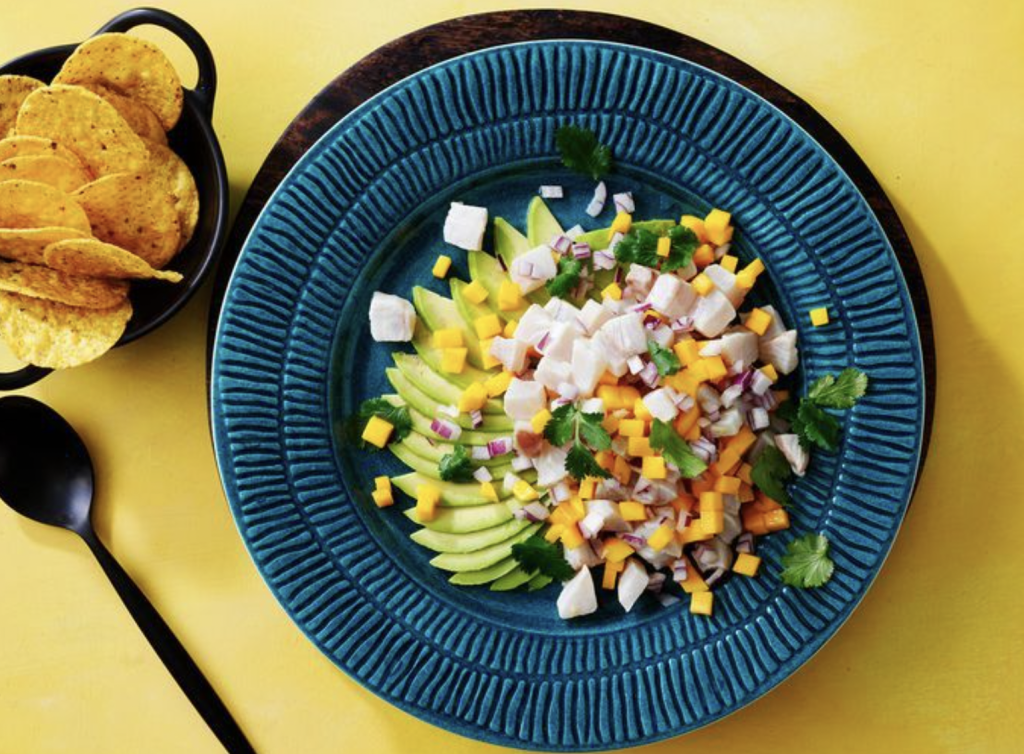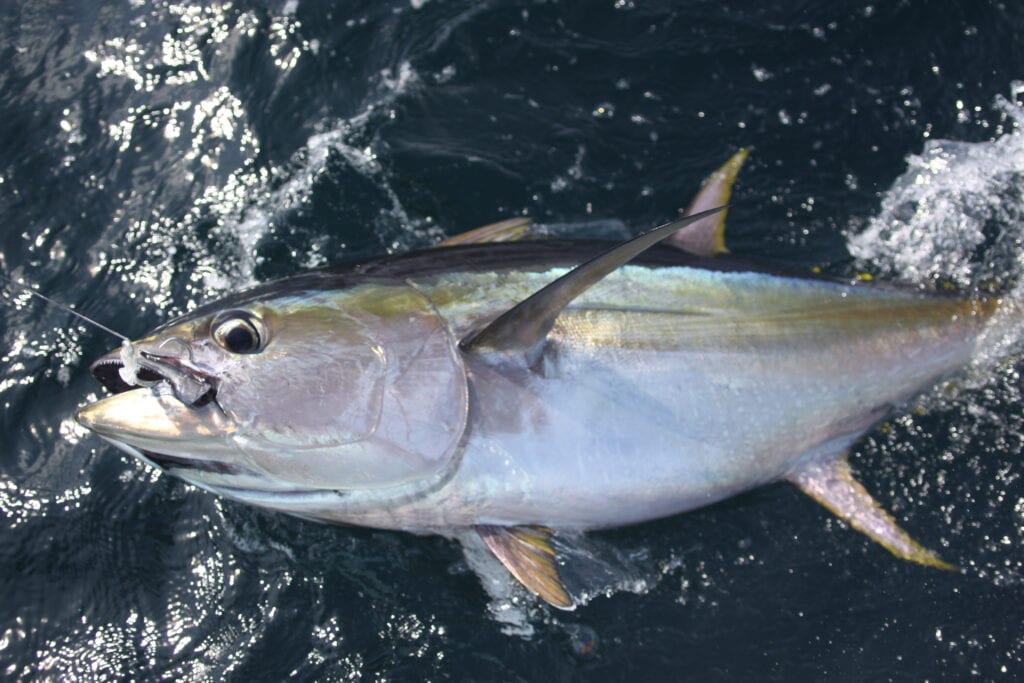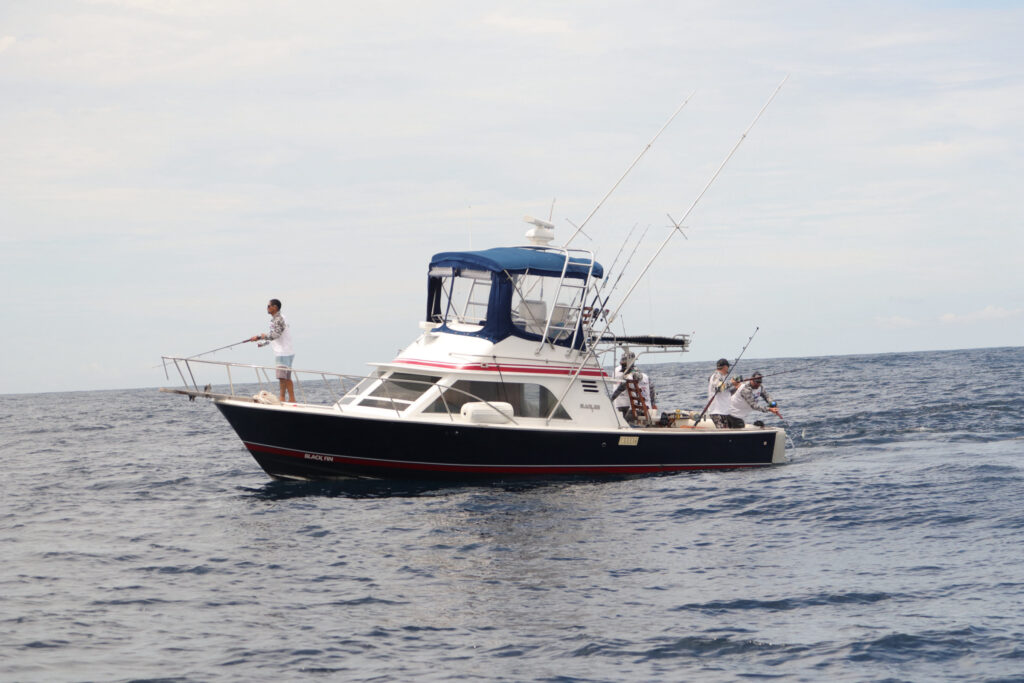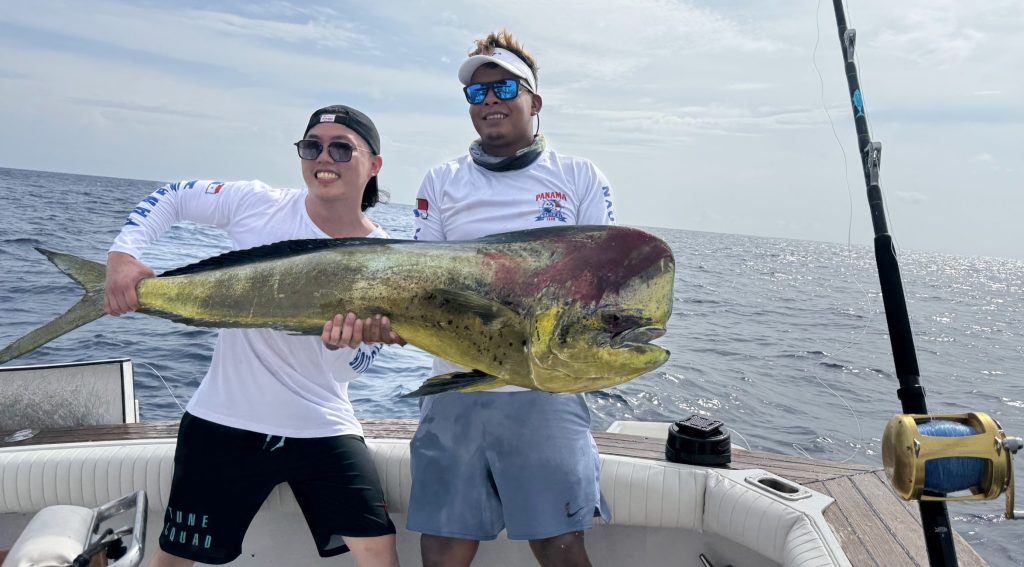Roosterfish have a distinct beauty and high-energy battle performance. The have become a fun pursuit for passionate anglers and marine life enthusiasts around the globe. In this article, we will delve into their characteristics, fishing techniques for and popular records in some of the best places to fish for Roosterfish.
Characteristics
Roosterfish are the primary target for most anglers for their strength and explosive runs and high-energy battle performance, making them a thrilling challenge for fly fishers. They have distinctive dorsal fins that resemble a rooster’s comb, and their size is quite large, with some specimens reaching over 50 pounds. They count with unique lateral lines and two prominent dark stripes, accentuating their elongated profile. These contrasting markings serve as a form of camouflage, providing them with an advantage when ambushing prey in the shimmering nearshore waters. When agitated or threatened, the Roosterfish has the astonishing ability to raise its dorsal fin dramatically, creating an impressive and eye-catching spectacle. However, when the fish is calm or swimming leisurely, the dorsal fin lies flat against its back, blending seamlessly with the rest of its body.
Distinctive Dorsal Fins
Roosterfish have seven long, spiky dorsal fins that can be erected when the fish is excited or threatened, resembling a rooster’s comb
Body Shape and Size
They have a streamlined, elongated body capable of quick bursts of speed. Adult Roosterfish commonly weigh between 20 to 50 pounds, but they can grow up to 100 pounds
Coloration
Roosterfish are typically a bluish-grey body with faint blue reflections and white underparts.
Diet and Feeding Habits
Their diet composes mainly of small fish, such as sardines and mullet. Generally the smaller roosters will feed on needlefish and sardines. The larger roosters will go after mackerel, mullet and ocassionally ballyhoo.
Habitat
Roosterfish are found in the warmer regions of the Eastern Pacific Ocean. They tend to prefer shallow waters along sandy or rocky shorelines, near reefs, and in areas with strong currents.
Conservation Status
They are not currently endangered. However, conservation efforts are important due to their popularity with recreational anglers.
How to Catch a Roosterfish
Catching a roosterfish can be an exciting and rewarding experience for anglers. This is particularly the case in Panama, which is home to a healthy population of roosterfish, some weighing 40 pounds or more. Here are some tips and tricks to help you increase your chances of successfully catching a roosterfish:
Gear
Appropriate gear and setup are necessary to fight the Roosterfish’s strength and the sometimes rough coastal environments where they are often found.
-
- The Perfect Tackle: A saltwater reel with a strong drag system and plenty of backing is crucial in handling their long, powerful runs. Opting for braided line can also increase sensitivity and better control.
- A strong, abrasion-resistant leader and tippet.
Bait and Lures
Live bait is often the preferred choice for roosterfish, popular choices are mullet, sardines, and mackerel. If live bait is not an option, artificial lures such as poppers, swimbaits, jigs, and topwater plugs that look like the baitfish roosterfish feed on can be successful. When fly fishing for roosterfish in calmer waters, Surface Poppers are ideal because the noise and splash attract the attention of Roosterfish from a distance. Streamers are another popular choice because they look like small local baitfish species, a perfect prey for Roosterfish looking for food.
Retrieval methods
- Strip Retrieval: Stripping the line in short, sharp pulls makes the fly dart back and forth, simulating an escaping fish.
- Variable Retrieval Speeds: The speed and rhythm of the strips can greatly influence the effectiveness of the lure. Sometimes a faster retrieve excites Roosterfish into attacking, while at other times, a slower, more deliberate pull might be more effective.
Time of day
Roosterfish are more active during low-light conditions such as early morning or late afternoon. If the anglers are hunting in areas with strong water movement, understanding Tides and Currents can help greatly. This will help in understanding local bait fish populations and in turn, predict Roosterfish behavior. Also, because Roosterfish can be spooky, approaching them with Stealth, smooth and slow movements in a boat is essential to minimize noise and avoid disturbing the water.
Sight Fishing
They have a tendency to come close to shore and cruise along the surf line. If you spot a roosterfish in shallow water, cast your bait or lure ahead of it and retrieve it in a way that mimics a wounded or fleeing baitfish.
Be Patient yet Ready for Action
Sometimes they can be picky eaters, so be patient. Once you get a strike, the fight can be intense, so be ready to handle the rod and reel with confidence. Maintain tension on the line during the fight to prevent the fish from throwing the hook.
Best Roosterfish Fishing Spots in the World
Roosterfish are a species that prefer tropical and subtropical waters. These warm waters (70 ºF to 85ºF or 21ºC to 29ºC) provide an optimal environment for their growth, reproduction, and survival. They can only be found in the coastal waters of the Eastern Pacific Ocean, between Peru and Baja Mexico. The sea of Cortez in Mexico has become a proven fishing ground for roosterfish. However, Panama and Costa Rica have some of the largest roosterfish. Here, you can find some of the best places to fish for Roosterfish in Panama, Mexico and Costa Rica:
Panama
Panama roosterfish fishing offers a thrilling and rewarding experience for anyone who loves the sport. In fact, most of the largest roosters have been caught in Panama. Panama also offers a wide variety of other gamefish species, including snapper, tuna, dorado (mahi-mahi), sailfish, and more. This diversity makes Panama a well-rounded fishing destination.
-
The Gulf of Chiriquí
The record was a catch of 85 pound Roosterfish, making it one of the best sports for trophy catches. Hannibal Bank is renowned for its big game fishing due to its deep waters and strong currents that contribute to the growth of these larger fish. These fish can be found around Islas Secas, Isla Coiba and Isla Paridas.
Recommended lodge: Selva Terra Resort in partnership with Panama Nautical Club, offers all-inclusive fishing packages with transfers to the lodge from Panama City, lodging, all-inclusive premium dining, and open bar. The lodge is within proximity to Roosterfish fishing spots, with the closest only 10 minutes away.
Mexico
-
The Bay Of Dreams
This magical secluded spot became even more memorable when an angler caught a 75 pound Roosterfish using live bait. This catch was particularly popular because of its size, which is quite significant for the species. It was also caught from the shore, which is a rarer and more challenging method of landing a roosterfish of that size.
Recommended lodge: Tailhunter International Sportfishing is based in La Paz and is known for their personalized service and knowledgeable guided fishing trips to the Bay of Dreams, specializing in local species like Roosterfish.
Costa Rica
-
Puerto Jiménez
Here, a 55 pound Roosterfish was caught on light tackle, making it remarkable given the lighter gear used. This is indicative of both the skill level required and the potential for big catches in Puerto Jiménez.
Recommended lodge: Crocodile Bay Resort is an eco lodge offering a comprehensive fishing package with experienced captains and crew. It includes the opportunity to fish in the rich waters around Puerto Jiménez and target Roosterfish among other species.
-
Golfo Dulce
A 65 pound Roosterfish was caught in this calm and deep waters using a popper fly. The angler’s ability to use surface flies and handle a large, aggressive fish was very impressive.
Recommended lodge: Golfo Dulce Fishing is specialized in inshore fishing with personalized trips targeting Roosterfish. Their captains are familiar with the best spots in the area to maximize your chances of a successful catch.
Catch and Release
The practice of catch and release is particularly important in roosterfish fishing. Given their status as a game fish rather than a target for culinary use, most anglers choose to release roosterfish after the catch. This practice is supported by the use of techniques and tackles that ensure the fish can be released with minimal harm. Using live bait, as opposed to certain types of lures, allows for a cleaner hook set, which can be easily removed, reducing stress and injury to the fish. This method not only respects the spirit of sportfishing but also contributes to the conservation of roosterfish populations, ensuring that these magnificent fighters can continue to thrive in their natural habitat.
In essence, while the pursuit of roosterfish might not end with a meal, it offers something perhaps more valuable: the joy of the sport, the beauty of a clean catch, and the satisfaction of knowing you’re participating in a sustainable fishing practice. Whether employing live bait or mastering the use of lures, the key to luring roosterfish lies in understanding their behavior, respecting their habitat, and committing to techniques that favor catch and release, ensuring these incredible creatures remain a vibrant part of the marine ecosystem.
Can You Eat Roosterfish?
When it comes to eating roosterfish, the answer is a bit complex. While you technically can eat roosterfish, they’re not commonly found in kitchens or restaurants. Catching a roosterfish at Panama Nautical Club is more about the adventure and challenge it presents rather than the meal it could become. The excitement of reeling in one of these powerful fish and the respect for the ocean and its creatures are what fishing here is really about.
For those curious about how roosterfish tastes, it presents a chance to try something out of the ordinary. Some report it tastes similar to dorado but a little chewier. The flavor of roosterfish is unique, and some adventurous eaters might find it interesting. However, most anglers prefer to capture the moment by taking photos with their catch and then releasing it back into the water. This practice not only respects the life of the roosterfish but also contributes to conserving marine populations for future generations to enjoy. In essence, while you can eat roosterfish, the experience of catching one and choosing to let it go is often viewed as more rewarding.




